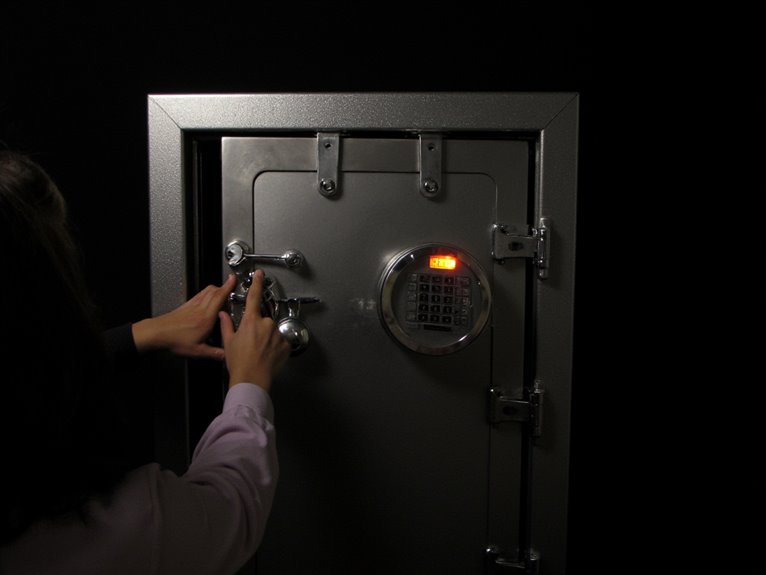Best Practices for Maintaining Your Gun Safe’s Security Features
You’ll need to inspect your gun safe quarterly, checking hinges, seals, and lock mechanisms for wear or tampering signs. Change electronic lock batteries annually and apply gun-safe-specific lubricants to bolts without petroleum products. Maintain humidity between 30-50% using dehumidifiers or desiccants to prevent corrosion. Update access codes every 3-6 months, avoiding obvious patterns like birthdates. Document all maintenance for warranty purposes and consider upgrading to biometric systems for enhanced protection. These foundational steps open advanced security optimization strategies.
We are supported by our audience. When you purchase through links on our site, we may earn an affiliate commission, at no extra cost for you. Learn more. Last update on 18th December 2025 / Images from Amazon Product Advertising API.
Notable Insights
- Perform quarterly inspections of exterior surfaces, hinges, seals, and lock mechanisms to identify wear and signs of tampering.
- Replace electronic lock batteries annually regardless of charge level and remove batteries during extended non-use periods.
- Change access codes every 3-6 months using unique patterns while avoiding obvious sequences like birthdates or sequential digits.
- Maintain humidity levels between 30-50% using dehumidifiers or desiccants to prevent rust and corrosion damage.
- Consider upgrading to biometric or advanced electronic locks with anti-drill plates and re-locking mechanisms for enhanced security.
Regular Inspection and Cleaning Protocols
While a gun safe provides robust protection for your firearms, its security depends entirely on consistent maintenance and systematic inspection protocols.
Establish quarterly inspection frequency to monitor structural integrity and security components. Check exterior surfaces, hinges, and seals for wear patterns or corrosion damage. Examine lock mechanisms carefully for tampering signs or operational irregularities that compromise security.
Conduct thorough quarterly inspections of all exterior surfaces, hinges, seals, and locking mechanisms to identify potential security vulnerabilities or structural deterioration.
Clean interior and exterior surfaces using appropriate cleaning agents. Apply mild, non-abrasive solutions with microfiber cloths to remove accumulated dust and debris. Avoid harsh chemicals that damage protective finishes or internal linings.
Wipe handles, dials, and external components with lightly dampened cloths for ideal surface maintenance. Position the safe away from direct sunlight to protect contents and finish from potential deterioration.
Monitor interior moisture levels consistently. Install desiccant packs or dehumidifiers to prevent rust formation on metal components. Update security codes biannually to enhance safe security and prevent unauthorized access.
Regular maintenance preserves both security functionality and firearm protection capabilities.
Lock Mechanism Lubrication and Battery Management
Beyond basic cleaning and inspection, your gun safe’s lock mechanisms require specialized maintenance to function reliably when you need access most.
Proper lock maintenance involves applying thin, even coats of gun-safe-specific lubricants to locking bolts, focusing on fronts, sides, and bottoms. Avoid heavy petroleum-based products that can swell plastic components like Delrin or Celcon found in mechanical locks.
External hinges benefit from oils like Tri-Flow, but keep lubricant away from internal locking units.
Battery safety demands annual replacement of electronic lock batteries, regardless of apparent charge levels.
Store spare batteries nearby for emergency situations. Test battery status regularly to prevent unexpected lockouts. Remove batteries during extended non-use periods to prevent corrosion damage. Use manufacturer-recommended high-quality batteries for peak performance and reliability.
Humidity Control and Corrosion Prevention
Your firearms face a constant threat from moisture that can penetrate even the most secure gun safe.
Controlling humidity levels and implementing effective corrosion prevention measures requires understanding both active dehumidification systems and passive moisture control techniques.
Without proper moisture management, even premium firearms stored in expensive safes can develop rust and corrosion that permanently damages their value and functionality.
Electric dehumidifier rods effectively control moisture in safes up to 200 cubic feet, while desiccant options utilizing rechargeable silica gel require no electrical connections and suit smaller storage spaces.
Moisture Control Methods
When moisture infiltrates your gun safe, it becomes a silent destroyer that can render firearms inoperable through rust and corrosion within weeks.
You’ll need effective moisture control methods to maintain the ideal 30%-50% humidity range at 60-70°F.
Electric dehumidifiers offer continuous protection through heating elements that maintain temperatures around 100-120°F. This warmth creates air convection, expelling moist air through door seals.
Popular models like Golden Rod and Peet Dryer require electrical outlets but provide reliable long-term operation.
Desiccant usage provides power-free moisture absorption through silica gel packs or dry rice. These compact solutions work effectively in sealed environments but require replacement every 3-4 months as they saturate.
You can combine both methods for enhanced protection in challenging environments.
Rechargeable dehumidifiers like Zarpax units operate without electrical connections and can be reactivated via microwave or sunlight when moisture indicators change color.
Firearm Rust Prevention
Moisture control alone won’t guarantee complete firearm protection against rust and corrosion. You’ll need additional strategies to assure VCI effectiveness and proper protective coatings application.
VCI emitters release corrosion-inhibiting vapors in sealed environments, protecting up to 50 cubic feet for one year. Apply quality gun oils to create moisture barriers on metal surfaces. Vacuum sealing eliminates oxygen exposure entirely, preventing oxidation in humid climates.
| Method | Coverage Area | Duration | Maintenance |
|---|---|---|---|
| VCI Emitters | 10-50 cubic feet | 12 months | Replace annually |
| Gun Oils | Direct application | 3-6 months | Reapply after use |
| Cosmoline | Complete coating | 2+ years | Thorough cleaning required |
| Vacuum Sealing | Individual firearms | Indefinite | Seal integrity checks |
| Bluing Treatment | Surface oxide layer | 6-12 months | Regular inspection |
Regular inspection identifies early corrosion signs, allowing prompt treatment before damage spreads.
Optimal Content Organization and Storage Methods
How effectively you organize your gun safe’s interior directly impacts both security and accessibility when you need your firearms most. Start with proper firearm categorization by separating handguns from long guns, then group by caliber within each category. This systematic approach reduces retrieval time during emergencies.
Implement vertical storage solutions for rifles to maximize shelf space for handguns and ammunition. Install pistol racks and door panel organizers to utilize every available inch. Custom-cut foam inserts prevent weapon shifting and protect finishes during access.
Store frequently used firearms in front positions while placing collector pieces toward the back. Use adjustable shelving systems with secure clips to prevent shifting.
Label each firearm’s position for quick identification without handling multiple weapons. This organization method maintains security while ensuring rapid access. When organizing your collection, consider that modern rifle safes accommodate varying firearm lengths and accessories like optics and scopes, so plan your layout accordingly to maximize both storage efficiency and protection.
Consider installing magnetic gun racks inside steel gun safes to efficiently organize rifles and shotguns using strong magnetic strips that hold firearms securely without damage.
Security System Upgrades and Access Code Management
Your gun safe’s security isn’t set in stone once you’ve installed it—upgrading lock systems and managing access codes properly can markedly enhance protection against unauthorized entry.
Modern lock upgrades offer mechanical, electronic, or biometric options that provide faster access times and stronger security protocols than standard factory locks.
Establishing regular code change schedules and implementing proper access management prevents security vulnerabilities that develop over time through repeated use or potential code compromise.
Advanced Lock Upgrades
When your existing gun safe no longer meets current security standards, advanced lock upgrades can transform outdated protection into modern defense systems without replacing the entire unit. Retrofit kits enable installation of sophisticated locking assemblies without full safe replacement.
Smart technology integration connects your safe to mobile monitoring systems, providing real-time alerts for unauthorized access attempts.
Lock customization options include biometric fingerprint readers, advanced keypads, and mechanical dial systems. High-grade steel reinforcement using Carbon, Stainless, or AR500 materials strengthens lock housing areas against forced entry.
Biometric systems store multiple authorized fingerprints while maintaining anti-spoofing protection against fake access attempts.
Advanced keypad technology eliminates backdoor vulnerabilities that compromise security. These upgrades include hardened steel bolts, anti-drill plates, and re-locking mechanisms that activate secondary systems when primary locks face tampering attempts.
Code Change Protocols
Effective access code management serves as your gun safe’s first line of digital defense, requiring systematic protocols that go beyond simple password creation. Change your codes every 3-6 months minimum, with immediate updates following personnel changes or suspected breaches.
Access code security demands unique personal codes for each authorized user rather than shared combinations. Implement role-based privileges restricting high-level access to essential personnel only.
Avoid obvious number patterns like birthdates or sequential digits. Store codes exclusively in encrypted digital formats or separate secure containers—never near the safe itself.
Code sharing risks multiply exponentially with each additional person who knows combinations. Establish immediate reset protocols for suspected compromises and maintain secure audit logs without recording actual codes.
Integrate tamper alerts with your broader security infrastructure for extensive protection.
Professional Maintenance Services and Documentation
Although gun safes represent significant investments in security infrastructure, they’re complex mechanical and electronic systems that require specialized expertise to maintain peak performance.
Professional technicians provide thorough repair services including mechanical lock adjustments, electronic component replacements, and bolt mechanism maintenance. These specialists can perform safe opening without unnecessary drilling, preserving structural integrity while resolving access issues.
Proper repair documentation guarantees warranty support remains valid throughout your safe’s operational life. Service records track combination changes, lock upgrades, and maintenance schedules for insurance purposes and ownership transfers.
Professional providers typically offer manufacturer warranties plus additional company assurances on completed work.
Scheduled maintenance includes cleaning, lubrication, and inspection of internal components. Regular professional checks detect potential vulnerabilities before system failure occurs, extending your safe’s lifespan while maintaining ideal security performance. Models with EMP protection require specialized diagnostic equipment to verify that electronic components and digital keypads maintain their electromagnetic pulse resistance capabilities. Technicians can also perform critical biometric access system calibrations to ensure fingerprint recognition continues to function accurately over time.
On a final note
You’ve invested considerably in your gun safe’s security capabilities. Don’t compromise that investment through neglect. Follow these maintenance protocols consistently to preserve lock integrity, prevent corrosion damage, and maintain ideal security performance. Document all maintenance activities and schedule professional inspections annually. Your safe’s protective features will only remain effective if you’re proactive about upkeep. Regular maintenance isn’t optional—it’s essential for long-term security reliability and equipment longevity.

